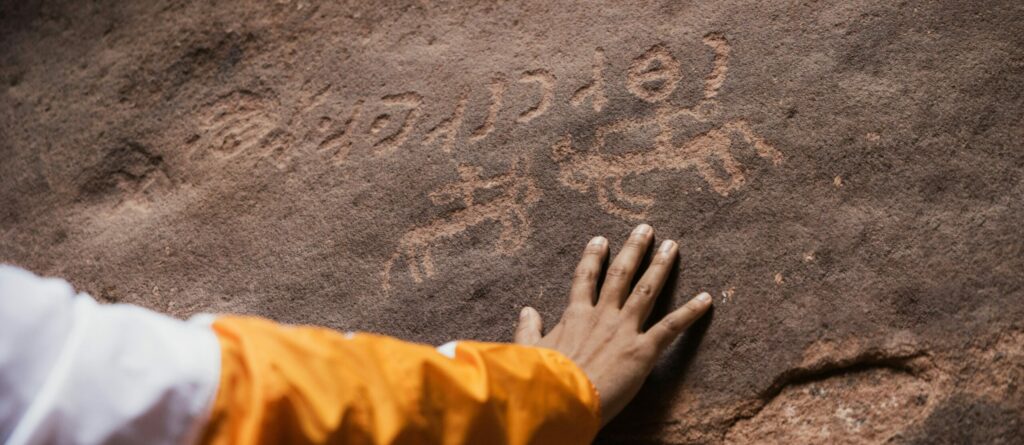Psilocybin has journeyed across millennia. This psychoactive compound is oven into the tapestry of human consciousness with a history as rich and complex as the human experience itself.
From ancient cave paintings to modern clinical trials, this naturally occurring psychedelic compound enlightens us about a unique aspect of our collective past.
In recent years, we’ve learned how archaeological revelations trace back to the very dawn of our species.
It is within this context that we uncover the profound intersection where ancient ritual converges with contemporary science, illuminating the timeless human fascination with psilocybin’s transformative potential.
What is psilocybin and how has it been used throughout history?
Psilocybin is a naturally occurring psychedelic compound found in certain species of mushrooms, commonly referred to as “magic mushrooms ” with a long illustrious history of use in various cultures around the world.
The use of psilocybin-containing mushrooms for spiritual and healing purposes can be traced back thousands of years. Several indigenous cultures in Central and South America, such as the Aztecs and Maya, even incorporated psilocybin mushrooms into religious ceremonies and rituals.
In more recent history, psilocybin gained popularity during the counterculture movement of the 1960s. It was embraced as a tool for exploring consciousness, expanding creativity, and promoting spiritual experiences.
However, due to its 1971 classification as a Schedule I substance by the U.S. Drug Enforcement Administration (DEA), psilocybin and psilocybin-containing mushrooms have been illegal in many countries. This led to limited scientific research on their potential benefits until recently.
This past decade has unveiled a resurgence of interest in psilocybin for its potential therapeutic applications. Clinical studies have shown promising results in the treatment of mental health conditions such as depression, anxiety, and post-traumatic stress disorder (PTSD).
Researchers believe that psilocybin may work by stimulating the brain’s serotonin receptors, leading to profound shifts in perception and consciousness.
Microdosing is a practice that involves taking sub-perceptual doses of psilocybin or other psychedelics, intermittently and for a limited time. Sub-perceptual doses are ingested a few days a week and for a limited number of weeks.
By 2017, microdosing gained popularity among tech founders seeking enhanced creativity, focus, and productivity. Advocates from all industries and a global cohort of microdosing citizen scientists believe that it can promote cognitive flexibility, mood enhancement, and increase energy levels without causing full-blown psychedelic experiences.
As our understanding of psilocybin continues to evolve, ongoing research and discussions are contributing to a more comprehensive understanding of its potential benefits and risks.
With increased scientific interest and shifting attitudes toward all psychedelic substances, the future of psilocybin research and its therapeutic applications looks promising.
Unveiling Prehistoric Psychedelia
Psychoactive substances, particularly magic mushrooms, manifest in the annals of prehistoric endeavors like a thread weaving through the fabric of human experience. From shadowy cave etchings to remnants of fungal spores, the archaeological record extols the profound relationship between early Homo sapiens and these mind-altering fungi.
These remnants serve not only as a testament to ancient practices but also spotlight the inherent human pursuit of altered consciousness, a quest seemingly as old as consciousness itself.
Cave Art: A Window Into Psychedelic Rituals
Did you know that cave paintings across the globe suggest an intrinsic relationship between early humans and the mystical experiences induced by psilocybin mushrooms?
Such renderings depict humans and mushrooms intertwined, signifying a possible sacramental use of psychedelics in prehistoric religious or healing rituals.
While definitive interpretations remain inconclusive, the art provides tantalising hints of psilocybin’s significance within the fabric of ancient society.
Artifacts and Alkaloids: Tracing Shamanic Tools
Shamanic artefacts suggest a profound historical connection to psilocybin’s transcendent effects.
- Stone Age relics: Engraved stones and mushroom-shaped figurines hint at early use.
- Pre-Columbian art: Statuettes and ceramics depict mushrooms in sacred contexts.
- Funerary remains Traces of psilocybin found with shamans interred in ritualistic settings.
- Ethnobotanical artifacts: Tools for cultivation and consumption of psilocybin mushrooms.
- Cave glyphs: Petroglyphs and pictographs indicating potential psychedelic practices. Such tools were central to the spiritual quests and healing practices of ancient cultures.
These shamanic instruments hint at evidence of ceremonial psychedelic use over the millennium.
Rituals and Rites: Evidence of Use
Through the archaeological lexicon, a narrative emerges of entheogenic ceremonies, intertwining psilocybin with spiritual transcendence and community cohesion. The remnants of ancient practices suggest that psilocybin mushrooms held a sacramental role, used within controlled, ritualistic contexts to facilitate experiences perceived as divine or enlightening.
Such practices likely served as both a connective and transformative force within early societies.
Expanding our understanding of these ancient cultures, one encounters the concept of a “mushroom complex.” This paradigm posits psilocybin’s central role in a variety of rites, rooted deeply within the ethos of a community. Through the embers of ritualistic fires and the residues found on ceremonial paraphernalia, the echo of ancient psychedelia whispers. In these rites, the ingestion of psilocybin was more than mere consumption; it was a sophisticated ritual, woven into the fabric of life and death, healing and celebration.
The Stoned Ape Theory
In 1992, the American ethnobotanist and mystic Terence McKenna hypothesised that approximately 100,000 years ago the transition from Homo erectus to Homo sapiens was made possible, in large part to the addition of psilocybin mushrooms (specifically the mushroom Psilocybe cubensis).
It would be improbable to prove such a theory and it is indeed rejected by many in the scientific community, but a fascinating consideration nonetheless.
Shamanic Ceremonies: Connecting the Dots
Other traces of ancient rituals pervade psychedelic historiography.
From Europe’s cave etchings to Mesoamerican relic depictions, the evidence of early psilocybin use is compelling. Intriguingly, these disparate cultural artifacts converge, painting a universal picture: psilocybin’s shamanic import. Such continuity across geographies intimates a shared understanding of the mushrooms’ transcendental capacity.
The shaman’s role was pivotal, a conduit between worlds.
Rituals often centered on transformation—personal, societal, and ecological. By harnessing psilocybin’s potency, shamans mediated between the tangible and the intangible, forging profound connections with the spiritual realm.
Through the gift of time and shared information, we begin to discern patterns of entheogenic evolution. The research potentially illuminates the nuanced ways psilocybin facilitated socio-cultural development, revealing an ancient yet persistent thread weaving through humanity’s spiritual fabric.
Psychedelic Patterns in Ancient Texts
Sadly, scholars often overlook the subtle imprints of psychedelia in ancient manuscripts. Within venerable tomes, cryptic references hint at experiences deeply aligned with altered states of consciousness induced by substances such as psilocybin.
Texts from the Vedic hymns of India to the shamanic narratives of South America are laced with allusions to journeys of the mind and soul. These scriptural passages often align with entheogenic experiences, suggesting psychoactive substances played a role in spiritual quests.
Metaphoric language akin to the effects of psilocybin consumption — transformative visions, profound realisations, and encounters with mythical beings — permeates these ancient chronicles, reinforcing their transcendent nature.
Symbolically, fungi held positions in a pantheon of sacred elements in archaic source material. Textual interpretations have led to the theories that mushrooms, akin to those that contain psilocybin, were a conduit for divine encounters, and therefore frequently featured in ritualistic and mythological contexts. This notion aligns with other historical evidence supporting the sacramental use of psychoactive fungi.
In scrutinizing these ancient narratives, one notices distinct parallels with contemporary descriptions of the psilocybin experience — moments of ineffable insight, dissolution of ego, and profound interconnectedness. Such similarities argue for a longstanding relationship between psychedelics and the pursuit of spiritual enlightenment, revealing a thread that stretches back to the dawn of recorded thought, and suggesting, perhaps, that these substances have influenced human cognition and culture for millennia.
Archaeochemistry: Unraveling Historical Use
Archaeochemistry merges archaeology with chemistry, providing a window into ancient psychoactive practices. By analysing residue on artefacts, scientists can postulate the consumption of psilocybin mushrooms by our ancestors.
The Selva Pascuala mural, with its evocative iconography, is a compelling case for entheogenic use long before the Common Era. Coupled with advanced residue analysis, such imagery offers tentative evidence of psilocybin ingestion. This provides rich insight into cognitive and spiritual practices, shaping a narrative of ancient psychedelic experiences, informed by both visual and chemical remnants.
Moreover, the presence of psilocybin metabolites in skeletal remains could offer a direct link to past usage. While residue analysis presents challenges, the advancement in technology promises potential discoveries of psilocybin’s historical applications, enabling a nuanced understanding of its role across different cultures and eras.
The quest to reconstruct the ancient narrative of psilocybin hinges on the symbiosis between archaeological evidence and chemical analysis. Through this interdisciplinary lens, we can trace the origins of mushroom consumption, enhancing our appreciation for the cultural and spiritual significance that these substances have carried through millennia, elucidating the practices surrounding their use and the profound depths they accessed within the human experience.
Global Footprints of Mushroom Veneration
Archaeological endeavors have unearthed emblematic artefacts and iconography, ranging from Saharan prehistoric rock art to Mesoamerican statuettes, which hint at the sacramental role of these fungi in ancient ceremonies.
Whether depicted in shamanic rituals of Siberian tribes or encoded in the enigmatic motifs of South American civilizations, the reverence for psilocybin-bearing mushrooms emerges as a profound and universal axis around which countless societies have revolved, experiencing the divine through their sacred mycological companions.
Indigenous Practices in the Americas
The ritualistic use of psilocybin mushrooms within Indigenous cultures of the Americas has woven a complex tapestry of spiritual and medicinal practices, deeply rooted in tradition and cosmology.
The Mazatec, Mixtec, Nahuatl, and Zapotec peoples, among others, utilized these sacred fungi, known respectively in their languages as nti-ši-tho, hongos, teonanácatl, and badao záza, in ceremonial contexts to facilitate shamanic journeys and divine communion. These practices, often entwined with pre-Columbian mythology, articulate a profound respect and understanding of psilocybin’s power to act as a conduit for healing, vision quests, and transcendental experiences, reaffirming the mushrooms’ esteemed status within their cultural heritage.
A detailed look at psilocybin use especially in Mesoamerica
Psilocybin use in Mesoamerica dates back to ancient times, deeply ingrained in the region’s cultural fabric.
- Preclassical Period: Evidence suggests the ceremonial use of psilocybin mushrooms during the Pre-classic period of Mesoamerica.
- Holy Rituals: Mushrooms were revered as sacred, and consumed by priests and nobility for spiritual communion and to receive divine visions.
- Spanish Conquest: Following the arrival of Spanish conquistadors, indigenous psilocybin use was suppressed and demonised, yet persisted clandestinely.
- Modern Rediscovery: In the 20th century, the Western world rediscovered these practices through anthropological research and travel accounts. Psilocybin rituals were integral to the spiritual life of Mesoamerican civilisations.
The fusion of psilocybin use with complex mythologies underscored its pivotal role in Mesoamerican spirituality.
Discussion on traditional rituals, ceremonial uses, and the spiritual significance of these mushrooms
Historically, psilocybin mushrooms forged an indelible link with spirituality, often manifesting in the form of intricate ceremonies. Here, participants communed with divine entities, believing in the transcendental power these mushrooms wielded.
Shamans acted as intermediaries in these sacred rites, leveraging psilocybin’s profound effects to mediate between the corporeal and the celestial. Their role was pivotal, harnessing the mushrooms to guide individuals through spiritual realms.
Rituals often coincided with significant calendrical events, marking transitions that were pivotal to societal and agricultural cycles. Psilocybin offered a bridge between worlds, a bridge between the mundane and the revered during these critical junctures.
Such ceremonies allowed participants to access deeper layers of consciousness, confronting personal and collective shadows, often leading to profound psycho-spiritual healing. This process was thought to rejuvenate both the individual’s spirit and the community’s cohesion.
At their core, these rites were operated as tools for societal structure and cohesion, intensifying communal bonds, and affirming cultural values and cosmologies. They provided a framework where the mystical and the practical intersected, facilitating transitions within the lifecycle of the community.
Today, there is a resurgence of interest in these ancient practices, as many seek to reconnect with lost spiritual traditions. Modern psychonauts often regard these ceremonial contours with reverence, eager to explore the historical depth and potential contemporary applications of psilocybin.
Mesoamerica’s Mushroom Stones
Mushroom stones are symbolic artefacts from ancient Mesoamerica, considered to bear religious significance.
- Guatemala: These stones were prominently discovered in the highlands, demonstrating early psilocybin use.
- Mayan and Aztec Civilizations: Mushroom stones reflect a deep cultural reverence for psilocybin mushrooms.
- Religious Ceremonies: They likely played a role in rituals, perhaps facilitating communication with deities.
- Form and Function: Often carved from volcanic rock, their designs range from simple to intricate, hinting at a hierarchy of use or significance.
- Anthropomorphic Features: Some stones blend mushroom shapes with human-like figures, symbolizing intertwined relationships between people, gods, and mushrooms.
Their presence argues for a sophisticated understanding of psychoactive plants.
These stones give credence to the theory of entheogenic rituals central to societal structures.
European Encounters
Historically, Europeans remained largely oblivious to psilocybin mushrooms until the arrival of the New World. Navigators and missionaries who ventured into these terrains encountered unfamiliar psychotropic practices among indigenous populations.
During the 16th century, Spanish friars documented indigenous rituals involving teonanácatl, a term meaning “flesh of the gods”. They were astounded by the profound and seemingly divine experiences this sacramental fungus precipitated. Despite their fascination, these encounters were often met with skepticism and condemnation, as these mind-altering substances defied the conservative European worldview.
As colonization progressed, attempts to suppress these psychoactive practices intensified. The European standpoint, anchored in Christian doctrine, viewed such rituals as pagan and heretical, leading to a decline in the ceremonial use of psilocybin mushrooms among conquered peoples.
Nevertheless, the ethnobotanical knowledge of psilocybin lingered through oral traditions and sparse documentation. It wasn’t until the 20th century that the Western world truly recognized the value of these entheogens, as anthropology and psychopharmacology unearthed and sought to understand their potential.
This Renaissance of psilocybin research marked a pivotal chapter in our cultural and medical history, transforming perceptions that had remained dormant for centuries.
Analysis of the cultural exchange and misunderstandings regarding the use of these mushrooms.
The cultural exchange between Europeans and indigenous peoples regarding the use of psilocybin mushrooms was marked by both fascination and misunderstanding. European explorers initially struggled to comprehend the spiritual and ceremonial significance that indigenous cultures attributed to these mushrooms.
Misinterpretations and misrepresentations often lead to a distorted understanding of their use. However, as explorers spent more time with indigenous communities, they began to appreciate the profound cultural and medicinal value that psilocybin mushrooms held. This analysis highlights the complexities of the cultural exchange surrounding the use of these mushrooms and underscores the importance of understanding and respecting diverse cultural practices.
Eurasia’s Shamanic Journeys
In the shadowy recesses of Eurasian prehistory, shamans were the intermediaries between the natural and the spiritual realms. These ancient practitioners would consume psychoactive substances to embark on soul flights—transcendent journeys believed to heal, divine, and guide their communities.
Archaeological findings, such as cave murals depicting figures with mushroom-like appendages, underscore a hypothesized relationship between early humans and psilocybin mushrooms.
These images, found in regions stretching from Spain to Siberia, serve as silent testimonies of the sacred practices that sought to harness the transformative power of these fungi. With each pictograph and artifact unearthed, the narrative of humanity’s fascination with psychedelic journeys deepens, echoing the timeless search for mystic wisdom.
Remarkably, these early uses were likely to be tied to complex cosmologies, where mushrooms played a pivotal role. Spanning Eurasia, Shamanic traditions integrated the altered states induced by psilocybin to transcend the corporeal plane, fostering profound experiences.
Through the veil of time, it’s discernible that these hallucinogenic voyages were integral to the spiritual fabric of early societies.
Moreover, as we delve into the medicinal provisions of these fungi, we confront the vast repositories of knowledge that ancient cultures may have held about their properties. It is plausible that alongside their religious endeavors, shamanic cultures utilized psilocybin mushrooms for therapeutic purposes.
This duality of sacred and medicinal uses underscores the multifaceted relationship that Eurasian societies had with psilocybin—a relationship informed by reverence, healing, and the pursuit of enlightenment.
What are some notable historical cultures that have used psilocybin?
Psilocybin, the psychoactive compound found in magic mushrooms, has been used by various historical cultures for centuries. Here are a few notable examples:
- Indigenous Cultures of the Americas
Several indigenous cultures in the Americas, such as the Aztecs, Maya, and Zapotecs, have a long history of using psilocybin-containing mushrooms for spiritual and ceremonial purposes. Archaeological evidence suggests that these cultures have been consuming magic mushrooms for thousands of years. - Ancient Mesoamerican Cultures
In Mesoamerica, psilocybin mushrooms held significant cultural and religious importance. The Aztecs referred to them as “teonanacatl,” meaning “flesh of the gods,” and considered them to be a sacred sacrament. Psilocybin mushrooms were used in rituals to communicate with deities, gain spiritual insights, and heal both physical and mental ailments. - Indigenous Cultures of Africa
Certain indigenous cultures in Africa, particularly in Central and Southern regions, have a tradition of using psilocybin mushrooms. The most well-known example is the use of “Amanita muscaria” mushrooms by the indigenous Khoisan people of Southern Africa. These mushrooms were believed to have powerful visionary and healing properties. - Ancient Asian Cultures
There is evidence to suggest that psilocybin mushrooms were also used by ancient Asian cultures. Artifacts found in archaeological sites in Siberia and Russia indicate the use of psychedelic mushrooms by the ancient Siberian tribes. These mushrooms were often consumed in shamanic rituals for spiritual enlightenment and divination. - Cultures of Oaxaca, Mexico
The Mazatec people of Oaxaca, Mexico, have a rich tradition of using psilocybin mushrooms, particularly the species known as Psilocybe mexicana. Spiritual healers, known as curanderas or curanderos, use these mushrooms in a practice called “velada.” Veladas involve a night-time ceremony conducted in darkness where participants consume the mushrooms to gain insight, healing, and personal growth.
It is important to note that while these cultures have historically used psilocybin mushrooms, the legality and regulations around the use of these substances vary in different regions today. It is always advisable to research and adhere to local laws and regulations when considering any form of psychedelic use.
How has the cultural perception of psilocybin evolved?
Psilocybin, the naturally occurring psychedelic compound found in certain mushrooms, has undergone quite a transformation in terms of cultural perception. It wasn’t always seen in a positive light, but over time, our understanding and appreciation of its potential benefits have grown by leaps and bounds.
Let’s take a gentle stroll through the key stages in the evolution of psilocybin’s cultural perception:
Psilocybin mushrooms have a rich history of human usage. Indigenous cultures around the world, like those in Mesoamerica, have been incorporating psilocybin-containing mushrooms into their rituals and spiritual practices for centuries. This ancient usage points to the early recognition of psilocybin’s profound psychological effects.
Ah, the swinging 60s! This groovy era brought psychedelic substances, including psilocybin, into the spotlight. Influential figures like Timothy Leary sparked interest in exploring altered states of consciousness for personal growth, spiritual insights, and expanding one’s perception. However, concerns about misuse and potential psychological risks led to increased regulations and a subsequent decline in research and cultural acceptance.
But fear not, my friend, for there’s a renaissance happening! In recent years, scientific interest in the therapeutic potential of psilocybin has experienced a resurgence. Researchers have been conducting studies that demonstrate its efficacy in treating various mental health conditions, such as depression, anxiety, and addiction. This growing body of evidence has played a significant role in shifting the cultural perception of psilocybin from a recreational drug to a potential medicine.
Psilocybin is now making its way into the mainstream. Celebrities, athletes, and influential figures have openly shared their positive experiences with microdosing psilocybin, helping to normalize its use. Mental health experts, researchers, and organizations are advocating for more comprehensive studies and the integration of psilocybin into therapeutic practices. And guess what? There’s even bipartisan support for the use of psilocybin as a mental health treatment.
Some regions and countries have taken steps towards decriminalizing or legalizing psilocybin. These changes acknowledge the potential benefits of responsible psilocybin use and aim to reduce the stigma associated with it. However, it’s important to note that regulations still vary greatly, so it’s crucial for individuals to be aware of the legal status in their specific jurisdiction.
We’ve come a long way and there’s a long way to go still.
Modern Rediscovery and Research
The resurgence of interest in psilocybin began with its synthesis in 1958 by Swiss chemist Dr. Albert Hofmann, who discovered the compound’s psychoactive properties.
Researchers like Timothy Leary popularized psilocybin’s psychological potential in the 1960s counterculture.
Intrigued by these mind-expanding properties, scientists began rigorous examination, leading to a proliferation of clinical studies exploring psilocybin’s therapeutic applications for mental health, including depression, anxiety, and addiction.
However, the sociopolitical climate of the 70’s led to the classification of psilocybin as a Schedule I substance, severely curtailing scientific exploration and banning all use.
Despite these significant setbacks, a decade-long renaissance in psychedelic research is now underway, promising to unlock the full potential and integrate psilocybin into modern therapeutic paradigms.
Summary of scientific research into the potential therapeutic benefits of psilocybin.
Recent studies and scientific studies have shown promising results in the treatment of various mental health conditions, including depression, anxiety, and addiction.
Psilocybin-assisted therapy has been found to facilitate profound and transformative experiences, leading to improved emotional well-being and a greater sense of connectedness.
The therapeutic effects of psilocybin are believed to stem from its ability to promote neuroplasticity, enhance emotional processing, and induce mystical or spiritual experiences.
As research continues to unfold, the therapeutic potential of psilocybin we are very hopeful that this compound will revolutionize mental health treatment.
In what ways has psilocybin influenced art and creativity throughout history?
Psilocybin has been a major source of inspiration for art and creativity throughout history. From ancient cave art to modern-day poetry, its influence is undeniable.
Those funky fungiform shapes found in prehistoric petroglyphs? Yeah, they suggest that people were tripping on mushrooms way back when.
And let’s not forget about the Renaissance alchemists who dropped hints about the mind-altering powers of mushrooms in their cryptic texts. They were definitely onto something.
In more recent times, the beat poets of the 20th century fully embraced the psychedelic experience. Aldous Huxley’s “The Doors of Perception” took a deep dive into the world of psilocybin, exploring the intersection of science, spirituality, and consciousness. It’s a mind-bending read, for sure.
But it’s not just in literature that psilocybin has left its mark. The psychedelic art movement of the 1960s brought us mind-blowing works from artists like Alex Grey and Robert Venosa.
Their vibrant and intricate pieces captured the essence of the psychedelic experience, with all its bright colors, intricate patterns, and surreal imagery. It’s like stepping into a whole new dimension.
And hey, did you know that psilocybin can actually boost creativity? It’s true! Studies have shown that it can enhance divergent thinking, helping you come up with all sorts of wild and innovative ideas. Plus, it can put you in a state of “flow,” where you’re totally immersed in your creative pursuits. It’s like a turbo boost for your artistic mojo.
So, whether you’re a fan of ancient cave art or modern-day poetry, psilocybin has had a profound impact on the world of art and creativity. It’s like a psychedelic muse, inspiring minds and pushing boundaries.
How has psilocybin been portrayed in literature, music, and other forms of media throughout different periods?
When it comes to literature, psilocybin mushrooms have sparked the imaginations of countless authors and poets.
These trippy fungi have found their way into works of fiction, non-fiction, and everything in between. Writers have tried to capture the mind-bending experiences that psilocybin can bring, diving into themes of altered perception, expanded consciousness, and spiritual awakening. Check out Aldous Huxley’s “The Doors of Perception“ or Carlos Castaneda’s “The Teachings of Don Juan“ for some mind-blowing reads.
But it’s not just literature that has been influenced by these magical mushrooms. Musicians have also taken inspiration from the psychedelic experiences induced by psilocybin.
Whether it’s The Beatles, Pink Floyd, or the Grateful Dead, these bands have woven references to psilocybin into their lyrics, album art, and overall vibe. Their music takes you on a trippy journey, exploring introspection, surrealism, and a cosmic connection that psilocybin can unlock.
And let’s not forget about movies and visual art. Filmmakers and artists have used psilocybin’s hallucinogenic properties to create mind-bending visuals and installations. Ever wondered if Disney was on LSD when he made Fantasia in 1940?
And if you’re looking for a list of mind-bending psychedelic movies, check out this blog post. These creative expressions give us a glimpse into the wild and colorful trips that psilocybin can take us on. So, buckle up and get ready for a mind-altering adventure through the realms of art and culture!
What are some of the key historical figures who have advocated for the use of psilocybin?
Throughout the years, several influential individuals have advocated for the use of psilocybin, recognising its potential benefits. Here are some key historical figures who have championed the use of psilocybin:
- Albert Hofmann: Considered the father of LSD, Albert Hofmann also recognised the medicinal and spiritual potential of psilocybin. Being a Swiss scientist, he conducted extensive research on the compound and contributed significantly to its understanding.
- Timothy Leary: A prominent figure in the 1960s counterculture movement, Timothy Leary advocated for the use of psychedelics, including psilocybin, as a means of expanding consciousness and exploring the inner realms of the mind. Leary’s work popularised the idea of using these substances for personal growth and psychological healing.
- Maria Sabina: A Mexican curandera, Maria Sabina played a pivotal role in introducing psilocybin mushrooms, known locally as “holy children,” to the Western world. Her spiritual use of these mushrooms during sacred rituals attracted attention and sparked interest in the potential therapeutic properties of psilocybin.
- Terence McKenna: A renowned ethnobotanist and advocate for psychedelic substances, Terence McKenna explored the profound effects of psilocybin on human consciousness. He was influential in emphasising the importance of the psychedelic experience and the potential benefits it can offer for personal transformation and spiritual growth.
- Alexander Shulgin: Known for his extensive work in psychopharmacology, Alexander Shulgin studied and synthesised various psychedelic compounds, including psilocybin. His research contributed to a deeper understanding of these substances and their potential therapeutic applications.
- John Hopkins Center for Psychedelic and Consciousness Research: While not an individual, the research conducted at the John Hopkins Center for Psychedelic and Consciousness Research has played a pivotal role in resurrecting interest in psilocybin as a potential treatment for various mental health conditions. Their studies have demonstrated the therapeutic potential of psilocybin in reducing anxiety and depression in cancer patients and potentially aiding in the treatment of other mental health disorders.
Each of these historical figures has contributed in their own way to the understanding and acceptance of psilocybin as a powerful tool for personal growth, spiritual exploration, and therapeutic potential.
Their work has paved the way for ongoing research and an open-mindedness toward access, education, and legalisation.
Conclusion
In conclusion, the journey of psilocybin mushrooms through the ages has been nothing short of mind-blowing.
From ancient civilisations to the modern world, these little fungi have made their mark on human history in a big way. We’ve explored how European explorers stumbled upon them, the fascinating research into their therapeutic potential, and how they influenced art, literature, and popular culture.
As we navigate the ever-changing legal landscape and chat with experts, it’s clear that psilocybin mushrooms continue to captivate and amaze, offering a unique window into the wild world of human consciousness.
So, buckle up and get ready for a trip like no other!
Join the conversation with other fellow community members here:
- Facebook group (8.000+ members)
- Discord channel (2.000+ members)
- Follow us on Instagram @microdosepro.amsterdam and @humanpro.amsterdam
- Follow me on Instagram @asha_md_coach
As always
Flow strong
Asha ✨







0 thought on “The Remarkable Journey of Psilocybin Through the Ages: A Cultural Odyssey”